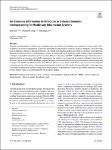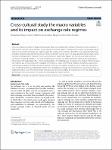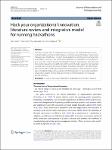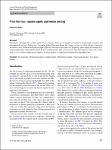Search
Author
- Osman, Ahmed I. (5)
- Daqing, Ma (3)
- Jorgensen, Ed (3)
- Li, Yan (3)
- next >
Subject
- kinh tế (26)
- Economics (12)
- programming (10)
- XRD (10)
- next >
Date issued
- 2020 - 2025 (2128)
- 2010 - 2019 (129)
- 2000 - 2009 (9)
- 1999 - 1999 (1)
Has File(s)
Search Results
Semantic interoperability establishes intercommunications and enables data sharing across disparate systems. In this study, we propose an ostensive information architecture for healthcare information systems to decrease ambiguity caused by using signs in different contexts for different purposes. The ostensive information architecture adopts a consensus-based approach initiated from the perspective of information systems re-design and can be applied to other domains where information exchange is required between heterogeneous systems. Driven by the issues in FHIR (Fast Health Interoperability Resources) implementation, an ostensive approach that supplements the current lexical approach in semantic exchange is proposed. |
This is an empirical analysis of study simultaneously focus on examining the impact of macroeconomic variables, i.e., GDP growth, GDP per capita, inflation, foreign direct investment, exports, imports, interest rates, foreign debt and foreign reserves on the exchange rate regimes, using the sample of five countries from MSCI developed markets index, emerging markets index and frontier markets index each from 1970 to 2020. This study predicts and provides several essential contributions for markets, financial and economic, that fills the gaps in the markets economic and financial literacy of desired countries. The study identifies and evaluates the impact using the most advanced statistical frameworks. This study adopts ML—binary logit (quadratic hill climbing) and investigates the c... |
Business-to-business (B2B) practitioners are increasingly interested in capabilities to holistically manage touchpoints along B2B customer journeys (CJs) to remain competitive. Research in the B2B context, however, has investigated neither what constitutes such a customer journey management capability (CJMC) nor how, whether, or when it creates value. Taking a mixed-methods approach, we conceptualize and operationalize B2B CJMC as a supplier's ability to achieve superior customer value along the B2B CJ by strategically creating value-anchored customer touchpoints characterized through the implementation of consistent resource usage across internal organizational boundaries and by continuously monitoring value creation toward the individual members of the buying center. Analyzing a m... |
This article aims to offer a comprehensive overview of the existing literature on the hackathon phenomenon to offer scholars a common ground for future research and managers and practitioners research-based guidelines on best planning and running a hackathon. A review of the most relevant literature on hackathons was conducted to serve as the research basis for our integrative model and guidelines. This article synthesizes the research on hackathons to offer comprehensible guidelines for practitioners while also providing questions for future hackathon researchers. We differentiate between the different design characteristics of hackathons while noting their advantages and disadvantages, discuss tools and methodologies for successful hackathon setup and execution step-by-step, and p... |
Digitalization has permeated all aspects of human lives, economies, and societies. This transformation has been driven by the rapid growth in computing power, storage capabilities, and data transmission infrastructures. These changes have enabled innovations, such as cloud computing, artificial intelligence, smartphones, digitalized homes, (semi) autonomous vehicles, quantum computing, and more. Digitalization has further resulted in faster, more effective service delivery by many organizations. The phenomenon of digitalization relies on an increasingly finite supply of resources, such as crude oil, silicon, and energy. Over the past 150 years, humans have consumed as many natural resources as they have consumed in the past 20,000 years. In part, this increasing clip of consumption ... |
The main challenge in empirical asset pricing is forecasting the future value of assets traded in financial markets with a high level of accuracy. Because machine learning methods can model relationships between explanatory and dependent variables based on complex, non-linear, and/or non-parametric structures, it is not surprising that machine learning approaches have shown promising forecasting results and significantly outperform traditional regression methods. Corresponding results were achieved for CAT bond premia forecasts in the primary market. However, since secondary market data sets have a panel data structure, it is unclear whether the results of primary market studies can be applied to the secondary market. Against this background, this study aims to build the first out-o... |
We present an optimization problem to determine the minimum capital requirement for a non-life insurance company. The optimization problem imposes a non-positive Conditional Value-at-Risk (CVaR) of the insurer’s net loss and a portfolio performance constraint. When expressing the optimization problem in a semiparametric form, we demonstrate its convexity for any integrable random variable representing the insurer’s liability. Furthermore, we prove that the function defining the CVaR constraint in the semiparametric formulation is continuously differentiable when the insurer’s liability has a continuous distribution. We use the Kelley-Cheney-Goldstein algorithm to solve the optimization problem in the semiparametric form and show its convergence. An empirical analysis is carried out ... |
Understanding clinical features and risk factors associated with COVID-19 mortality is needed to early identify critically ill patients, initiate treatments and prevent mortality. A retrospective study on COVID-19 patients referred to a tertiary hospital in Iran between March and November 2020 was conducted. COVID-19-related mortality and its association with clinical features including headache, chest pain, symptoms on computerized tomography (CT), hospitalization, time to infection, history of neurological disorders, having a single or multiple risk factors, fever, myalgia, dizziness, seizure, abdominal pain, nausea, vomiting, diarrhoea and anorexia were investigated. Based on the investigation outcome, decision tree and dimension reduction algorithms were used to identify the afo... |
Prices have a leverage effect on firm profits. Prices, however, have also an impact on customer’s perceived price fairness and thus indirectly on firm’s bottom line. A growing body of literature shows this. Papers on the level of the fair price, however, are rather scarce. Based on different concepts of justice, two levels of fair prices are proposed: square equity and mean prices. I run an experiment which shows that both are considered fairer than cost-based or value-based prices. The results can be used to assess fairness implications of prices ex ante and hence complement traditional pricing approaches. |
Narratives are playing an increasingly important role in economics since their performative character has been realised. Banks are not unaffected by this, as they face many future challenges and are thus directly affected by narratives. For this reason, this article aims to reveal the future prospects within the academic landscape on the basis of a scoping literature review to create transparency about where the narratives come from. So, it is not the intention to make another prediction about the future of the banks. The paper presents contributions that make explicit statements about the future of banks, either a description of the future or an assessment of the future prospects of banks. Two databases were searched in this context, IDEAS/RePEc and Scopus, for the period from 2001... |










